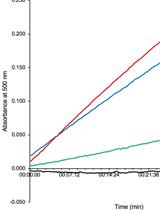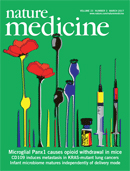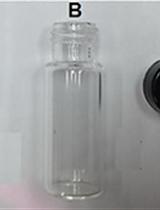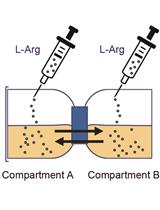- EN - English
- CN - 中文
Mass Spectrometry-based in vitro Assay to Identify Drugs that Influence Cystine Solubility
基于质谱法的体外实验鉴定影响胱氨酸溶解度的药物
发布: 2017年07月20日第7卷第14期 DOI: 10.21769/BioProtoc.2417 浏览次数: 8578
评审: Jyotiska ChaudhuriMarieta RusevaRakesh Bam

相关实验方案

从垢分支杆菌中通过双功能酶,4-氨基-4-脱氧胆固醇裂解酶/D-氨基酸转氨酶、转氨酶产生的D-谷氨酸的检测
Helen K. Opel-Reading [...] Kurt L. Krause
2019年01月05日 5650 阅读
Abstract
Cystinuria is a rare genetic disorder characterized by recurrent, painful kidney stones, primarily composed of cystine, the dimer of the amino acid cysteine (Sumorok and Goldfarb, 2013). Using a mouse model of cystinuria, we have recently shown that administration of drugs that increase cystine solubility in the urine can be a novel therapeutic strategy for the clinical management of the disease (Zee et al., 2017). There is a large unmet need in the field for developing new drugs for cystinuria. To that end, here we describe a simple in vitro cystine solubility assay that is amenable for screening compounds to identify potential drugs that may influence cystine solubility. The assay includes preparing a supersaturated solution of cystine, incubating this solution with drug(s) of choice, and finally using high pressure liquid chromatography–tandem mass spectrometry (HPLC-MS/MS) to quantify the amount of cystine precipitated under various conditions.
Keywords: Cystinuria (胱氨酸尿)Background
Cystinuria is a type of kidney stone disease characterized by a genetic defect in cystine transporters in the proximal tubule of the kidney, resulting in massive increase in cystine load in the urine that precipitate as kidney stones (Sumorok and Goldfarb, 2013). While categorized as a rare genetic disorder (~1/15,000 individuals) (Milliner and Murphy, 1993; Palacin et al., 2001), patients suffering from cystinuria experience excruciating pain from recurrent stone episodes (Dent and Senior, 1955). Unlike other, more common kidney stone types (such as calcium oxalate- or uric acid-based), cystine stones are denser and resistant to extracorporeal shock wave lithotripsy (SWL), requiring patients to undergo multiple emergency room visits and surgical procedures to remove obstructive stones (Mattoo and Goldfarb, 2008). The current drug regimen for cystinuria are geared towards either increasing urinary pH (potassium citrate) or reducing urinary cystine levels (thiol drugs, such as tiopronin), which are generally associated with serious side effects (Koraishy et al., 2013; Sumorok and Goldfarb, 2013; Saravakos et al., 2014). Further, clinical (Becker et al., 2007) and murine model (Zee et al., 2017) studies have found little evidence that these drugs are ultimately effective and long-term patient compliance is poor. Thus, there is an urgent need for developing effective therapies to treat cystinuria. Our recent results show that increasing urinary cystine solubility can be a viable alternative strategy for drug development in cystinuria. Herein, we describe an in vitro cystine solubility assay to identify novel compounds capable of influencing cystine solubility.
Materials and Reagents
- Gloves
- Lab coat
- Culture tubes (16 x 100 mm) (VWR, catalog number: 47729-576 )
- 4 ml glass vials and caps (13-425 thread finish, borosilicate glass) (VWR, catalog number: 46610-706 )
- HPLC autosampler vials and caps (9-425 thread finish) (VWR, catalog number: 89523-482 )
- Pipette tips (standard 1,000 µl and 200 µl)
- Gel loading pipette tips (VWR, catalog number: 37001-150 )
- Joint clips to attach the round bottom flask to Allihn condenser (VWR, catalog number: 89426-304)
Manufacturer: GLASSCOLABS, catalog number: 007.470.05A . - Eppendorf tubes (standard 1.5 ml)
- Ammonium acetate (for LC-MS LiChropur®) (EMD Millipore, catalog number: 533004 )
- Water (HPLC-grade) (VWR, BDH®, catalog number: BDH23595.400 )
- Ammonium hydroxide (28% NH3 in H2O, ≥ 99.99%) (Sigma-Aldrich, catalog number: 338818 )
- 3,3,3’,3’-d4-L-cystine (98%) (Cambridge Isotope Laboratories, catalog number: DLM-1000-1 )
- L-cystine (≥ 98%) (Sigma-Aldrich, catalog number: C8755 )
- DL-cystine dimethyl ester dihydrochloride (≥ 95%) (Sigma-Aldrich, catalog number: 857327 )
- Acetonitrile (HPLC-grade) (VWR, BDH®, catalog number: BDH83639.400 )
- Ammonium acetate solution (see Recipes)
Note: Specific brand and catalog number (as used in our work) have been provided for the materials and reagents listed. However, we do not explicitly endorse any of these brands or products and most items can be obtained from other reputed vendors. Further, most of these product/catalog numbers are based on the current availability in the United States, so researchers in other countries may find it necessary to obtain materials from another vendor.
Equipment
- pH meter (standard)
- Safety goggles
- Chemical safety hood
- Glass bottles (standard 500 ml and 1 L)
- Glass measuring cylinders (standard 1 L, 250 ml, and 100 ml)
- Glass round bottom flask (standard 24/40 ground joint, 100 ml)
- Magnetic stir-bar (standard)
- Reflux apparatus (standard, consisting of stirring-heating mantle, Allihn condenser with a water jacket and 24/40 junction, running water source, rubber tubing, and clips for attachment). Follow vendor instructions for assembly
- Pipettes (standard 1,000 µl and 200 µl)
- Vortex (standard)
- -20 °C freezer (standard)
- 4 °C incubator or fridge (standard)
- HPLC-MS system:
- HPLC: Shimadzu UFLC prominence system (HPLC) (Shimadzu, model: Prominence UFLC ) fitted with following modules: CBM-20A (Communication bus module), DGU-A3 (degasser), two LC-20AD (liquid chromatograph, binary pump), SIL-20AC HT (auto sampler)
- HPLC column: Luna® NH2 column (2 x 50 mm, 3 µm, 100 Å) (Phenomenex, catalog number: 00B-4377-B0 )
- Mass Spectrometer: AB Sciex 4000 LC-MS/MS mass spectrometer (AB Sciex, model: QTRAP® 4000 ) fitted with a Turbo VTM ion source
- Centrifuge (standard, with attachment for 4 ml vials)
- Weighing scale (standard)
Note: Standard lab equipment should be used for this assay as indicated. Specific brand and catalog numbers (as used in our work) have been provided for components of the HPLC-MS setup–these can be replaced by equipment from other vendors; arguably any HPLC-MS setup will work with this assay, but may need additional optimization based on vendor-provided instructions.
Software
- AB Sciex’s Analyst® v1.6.1 for data acquisition, development of LC method, and optimization of analyte-specific MRM (multiple reaction monitoring) transitions
- AB Sciex’s Peakview® v2.1 and Skyline® v3.623 for LC-MS/MS data analysis
Procedure
文章信息
版权信息
© 2017 The Authors; exclusive licensee Bio-protocol LLC.
如何引用
Bose, N., Zee, T., Kapahi, P. and Stoller, M. L. (2017). Mass Spectrometry-based in vitro Assay to Identify Drugs that Influence Cystine Solubility. Bio-protocol 7(14): e2417. DOI: 10.21769/BioProtoc.2417.
分类
生物化学 > 其它化合物 > 氨基酸 > 胱氨酸可溶性
您对这篇实验方法有问题吗?
在此处发布您的问题,我们将邀请本文作者来回答。同时,我们会将您的问题发布到Bio-protocol Exchange,以便寻求社区成员的帮助。
提问指南
+ 问题描述
写下详细的问题描述,包括所有有助于他人回答您问题的信息(例如实验过程、条件和相关图像等)。
Share
Bluesky
X
Copy link














